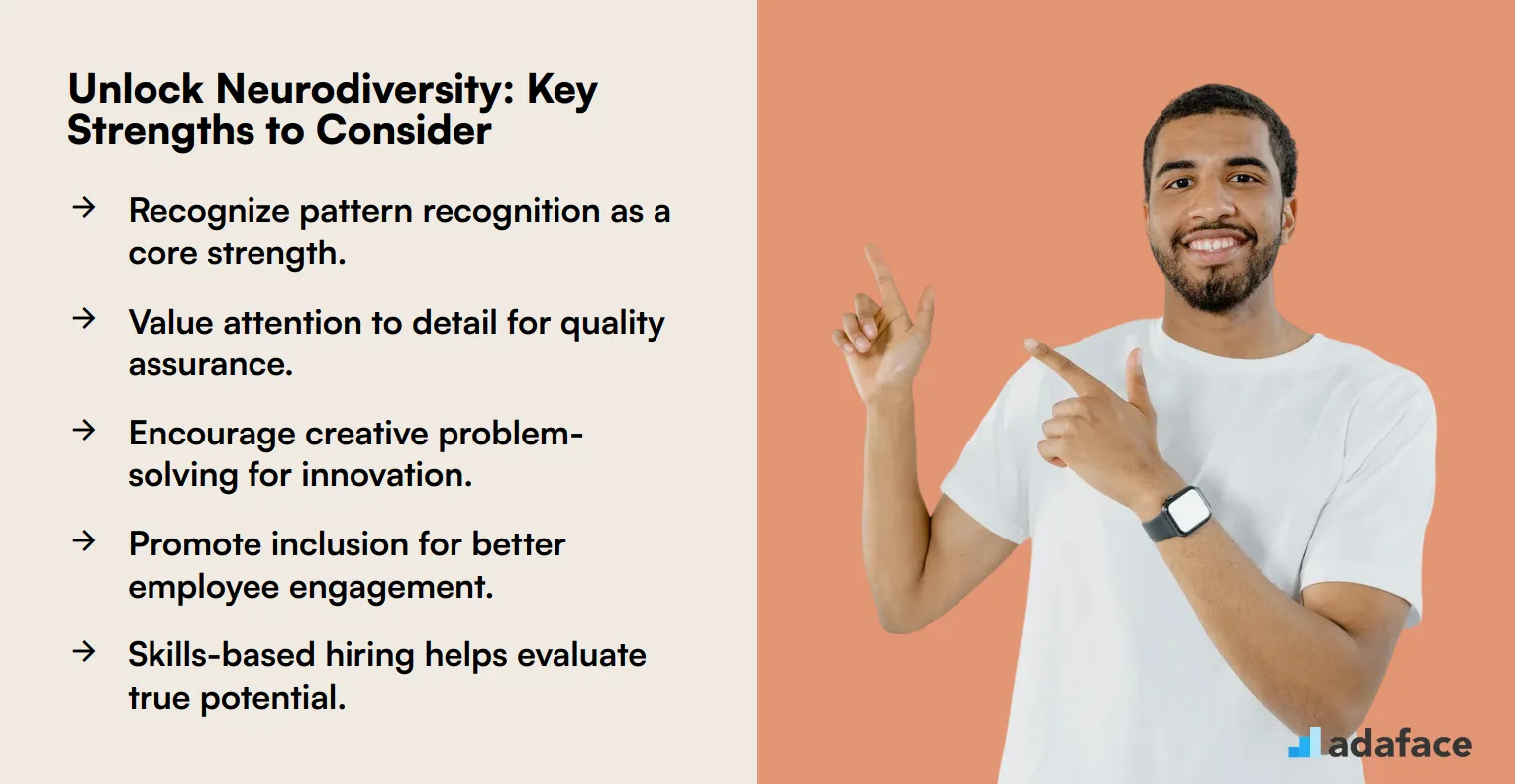Many companies are realizing the benefits of inclusive hiring practices. Let's explore how to adapt your recruitment processes to attract and support neurodiverse talent.
Neurodiversity includes a range of neurological differences, such as autism, ADHD, and dyslexia. Understanding these differences allows you to create a more equitable and productive work environment.
Table of contents
Understanding Neurodiversity in the Workplace
Understanding neurodiversity in the workplace is like discovering a hidden treasure of untapped potential. It involves recognizing that individuals think, process, and interact with the world differently, which can be a tremendous asset in a diverse work environment.
Neurodiversity encompasses a range of conditions such as autism, ADHD, dyslexia, and more, each bringing unique strengths and perspectives. Embracing these differences can foster innovation and creativity, driving your organization forward.
Creating an inclusive environment for neurodiverse individuals means adapting recruitment and interview processes to accommodate diverse needs. This might involve providing clear instructions, allowing extra time for tasks, or using alternative communication methods.
By fostering a culture that values diverse cognitive abilities, companies can enhance team dynamics and problem-solving skills. This approach not only benefits the employees but also contributes to a more inclusive and dynamic workplace.
Ultimately, understanding neurodiversity is about valuing differences and recognizing the potential they bring to the table. It's about creating an environment where everyone can thrive, contribute, and feel valued.
Common Neurodivergent Conditions
While neurodiversity includes many variations in brain function, some conditions are more commonly recognized. Understanding these can help you create a more inclusive hiring process, just as understanding the big five personality traits can help you build better teams. Here's a quick rundown of some common neurodivergent conditions.
Autism Spectrum Disorder (ASD): ASD affects communication, social interaction, and behavior. Individuals with ASD may have unique strengths in pattern recognition, attention to detail, and logical thinking.
Attention Deficit Hyperactivity Disorder (ADHD): ADHD involves difficulties with attention, hyperactivity, and impulsivity. People with ADHD often demonstrate creativity, hyperfocus on tasks of interest, and high energy levels.
Dyslexia: Dyslexia primarily impacts reading and spelling abilities. Many dyslexic individuals possess strong visual-spatial skills, problem-solving abilities, and a talent for thinking outside the box.
Dyspraxia (Developmental Coordination Disorder): Dyspraxia affects motor skills, coordination, and sometimes speech. Those with dyspraxia may excel in creative fields, demonstrate strong problem-solving skills, and possess determination.
Tourette Syndrome: Tourette Syndrome involves repetitive movements or unwanted sounds (tics). Individuals with Tourette's often display creativity, resilience, and a unique perspective.
Benefits of Neurodiverse Hiring
Neurodiverse hiring brings unique perspectives and skills to the workplace. By embracing neurodiversity, companies can tap into a pool of talented individuals who think differently and offer innovative solutions to complex problems.
Neurodivergent employees often excel in pattern recognition, attention to detail, and creative problem-solving. These strengths can lead to increased productivity and efficiency in various roles, particularly in fields like technology, data analysis, and quality assurance.
Diversity in thought processes enhances team dynamics and fosters a more inclusive work environment. This can result in improved employee engagement and overall job satisfaction for all team members.
Neurodiverse hiring can also boost a company's reputation as an inclusive employer. This positive image can attract top talent from all backgrounds and potentially lead to increased customer loyalty.
Finally, embracing neurodiversity can drive innovation and give companies a competitive edge. The unique perspectives of neurodivergent individuals can lead to groundbreaking ideas and solutions that may have been overlooked in more homogeneous teams.

Adapting Recruitment Processes
Adapting recruitment processes to accommodate neurodiverse candidates involves rethinking traditional hiring practices. This means creating a more inclusive environment where diverse talents can thrive and contribute effectively.
One approach is to modify interview techniques to reduce stress and anxiety for neurodiverse candidates. For example, providing questions in advance or allowing alternative interview formats can help candidates showcase their true potential.
Additionally, it's important to focus on skills and abilities rather than conventional qualifications. This can be achieved by incorporating skills-based hiring assessments that evaluate a candidate's practical skills instead of relying solely on resumes.
Another strategy is to train hiring managers and recruiters on neurodiversity awareness. This training can help them understand the unique strengths of neurodiverse individuals and how to effectively communicate and evaluate them.
Finally, fostering a supportive work environment is crucial for retaining neurodiverse employees. This includes offering flexible work arrangements and providing resources for continuous learning and development.
Creating an Inclusive Interview Environment
Creating a space where neurodivergent individuals can shine starts with understanding their needs, and adjusting your interview process accordingly. An inclusive hiring process benefits everyone, not just neurodivergent candidates.
Start by providing clear, structured agendas beforehand, so candidates know what to expect during each stage. Offer options for communication, such as written questions in advance or allowing candidates to respond in writing after the interview.
Consider the environment: minimize sensory distractions like bright lights or loud noises. Allowing candidates to take breaks or move around can also help manage anxiety. These small changes contribute to a more positive candidate experience and allow individuals to present their best selves.
Train your interviewers on neurodiversity and unconscious bias in hiring. Emphasize the importance of focusing on skills and experience, rather than relying on subjective impressions or social cues. This ensures a fair evaluation and helps you identify top talent you might otherwise miss.
Supporting Neurodiverse Employees Post-Hire
Supporting neurodiverse employees post-hire is about creating an inclusive and understanding work environment. It's about recognizing their strengths and providing the support they need to thrive, much like how a buddy program can help new hires settle in.
Start with clear communication; provide instructions in multiple formats (written, verbal, visual) to cater to different processing styles. Offer flexible work arrangements, such as flexible hours or remote work, to accommodate sensory sensitivities or focus needs.
Provide noise-canceling headphones, quiet workspaces, or sensory tools to help manage sensory overload. Regular check-ins are key; schedule regular one-on-one meetings to discuss progress, challenges, and needed accommodations.
Offer targeted training to managers and colleagues to promote understanding and acceptance of neurodiversity. Encourage open dialogue and create a culture where neurodiverse employees feel comfortable disclosing their needs and asking for support. Remember that a strong retention strategy includes supporting all employees.
Conclusion
Hiring neurodiverse talent is a step towards fostering a more inclusive and innovative workplace. By understanding and adapting to the unique needs of neurodivergent individuals, companies can unlock a wealth of untapped potential.
Recruiters and HR professionals play a key role in this transformation by creating supportive environments and processes. Embracing neurodiversity not only benefits employees but also enriches the organization's culture and performance.
Neurodiverse Hiring FAQs
Common misconceptions include assuming all neurodivergent individuals have the same strengths and weaknesses. Another is believing that accommodations are always costly or difficult to implement. It's essential to understand that neurodiversity is a spectrum, and each individual's needs are unique.
Use clear, concise language and avoid jargon. Highlight the core responsibilities and skills required. Consider providing examples of tasks or projects.
Accommodations can include flexible work schedules, quiet workspaces, noise-canceling headphones, and clear communication protocols. Providing written instructions and allowing extra time for tasks can also be beneficial. The goal is to create a supportive environment where everyone can thrive.
Maintain clear and consistent communication throughout the hiring process. Provide timely updates and feedback to candidates. A positive candidate experience can significantly reduce ghosting.
Ghosting can be attributed to various factors, including a competitive job market and poor communication from employers. Candidates may also ghost if they feel undervalued or disrespected during the recruitment process. It's essential to treat candidates with respect and transparency.
Track metrics such as the number of neurodiverse employees hired, retention rates, and employee satisfaction. Conduct surveys and focus groups to gather feedback from neurodiverse employees. Use this data to refine your strategies and ensure ongoing improvement.

40 min skill tests.
No trick questions.
Accurate shortlisting.
We make it easy for you to find the best candidates in your pipeline with a 40 min skills test.
Try for freeRelated terms



